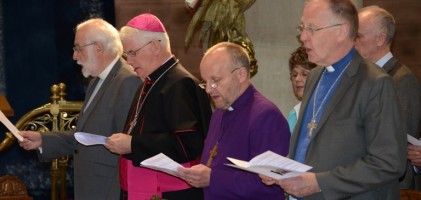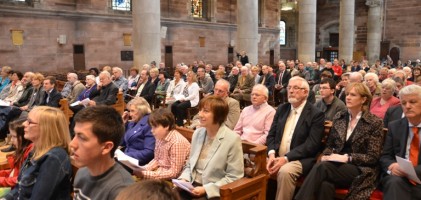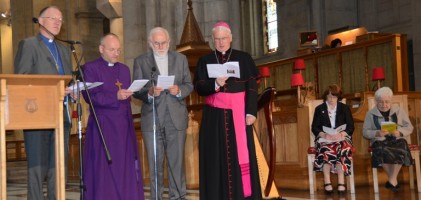Dear Friends,
I am delighted to be here with you this evening. I thank the Very Revd John Mann for his invitation to spend this time together. I greet each and every one of you. Recently Belfast was very much to the fore on the worldwide stage of the Focolare Movement through its participation in the Run4Unity, a virtual relay race, in which young people pass a baton from country to country across the globe to cover the world with a rainbow of peace and unity promoting the Golden Rule to treat others as you wish they treat you. The Northern Ireland leg took place in Stormont. Along with more than 400 young people there were representatives of different political parties and religious leaders. I would like to take this opportunity to thank some of them who are here today for their contribution and support.
 I have been asked to speak this evening on the theme of ‘Building community through a culture of trust’. I know that the Belfast Good Friday Agreement emphasizes the desire for a new beginning and speaks of ‘dedication to bringing about reconciliation, tolerance and mutual trust’.
I have been asked to speak this evening on the theme of ‘Building community through a culture of trust’. I know that the Belfast Good Friday Agreement emphasizes the desire for a new beginning and speaks of ‘dedication to bringing about reconciliation, tolerance and mutual trust’.
For us Christians, the link between building communion and the culture of trust has its foundation in God. If God, who is in himself love and therefore communion, loves us immensely and entrusts us with building up communion in all corners of the earth by uniting us to His Son Jesus, in the fellowship of the Holy Spirit, we can and we must trust one another to carry ahead this marvellous project.
Recently I was in Guatemala, where I met members of the different cultures that make up the people of Guatemala – Maya, Garifuna, Xinca, Mestizo. In that context we said that in a world in need of cohesion and solidarity, we must let go of a prevailing ‘culture of suspicion’, so that a culture of trust can take root deeply, both in our personal feelings towards other people, and in building with dedication, day after day, a new cultural foundation, which can be a source of social coexistence respectful of diversity.
But how can we promote this culture? Tonight I want to suggest three elements: the art of loving that can be found in the Gospel, the love that blossoms into a mutual pact, and Jesus Crucified and Forsaken, the model and key of love. What I will share will be in the light of the spirituality of unity, characteristic of the Focolare Movement, which I represent.
The art of loving
Right from the beginning of the Focolare Movement, which was born during the Second World War, one of the things that the Holy Spirit suggested to Chiara Lubich, founder of the movement, was to live the Gospel. She understood that the Gospel contained in an ‘art’ of loving that creates the community, establishing new relationships of trust as the solid foundation of the community. The love that Jesus brought on earth has, in fact, some typical characteristics that generate trust. For example:
1) Christian love takes the initiative in loving, it does not expect to be loved, it does not love for self–interest or for other reasons. As we read in Letter to the Romans this is what Jesus did: ‘while we were yet sinners, Christ died for us’ (Rom. 5: 5);
2) Christian love consists in loving of neighbour ‘as yourself’ (cf.Gal 5:14). The other is really ‘another me’;
3) Christian love prompts us to act like our heavenly Father who ‘makes his sun rise on the evil and on the good, and sends rain on the righteous and on the unrighteous’ (Matt. 5: 45). That is, the love of the Gospel urges us to love everyone, really everyone, without the usual distinctions that we make so easily between people of different political parties, different churches, different views;
4) Christian love includes love for our enemies: ‘Love your enemies – says Jesus in the Gospel of Matthew – and pray for those who persecute you’ (Mt 5:43–48).
Living this art radiates confidence. Of course, this art needs to be learned and re–learned every day. Let me tell you an experience. For several years the families of our movement have a dice called ‘the cube of love’. On each side there is a motto to remind us how to love in accordance with the Gospel. Every day the dice is rolled and then we try to live the Gospel phrase during the day and, when appropriate, share our experiences.
Flor de Maria, a young girl from Mexico, describes her experience: ‘When there is a difficulty, I always try to love. For example, the other day my mother and father had quarrelled. I was sad and I thought: “How I wish they were happy! What can I do?” I went to José and Juan, my brothers. With coloured paper we drew some pictures of hearts and flowers that we stuck on the wall, then we went to Mum and Dad who were watching TV in silence. We turned off the TV and I sang a song about the love between us. They said sorry to one another, and Mum started crying with joy. I was also very happy because finally peace returned to our family, and I thanked Jesus.’
The Art of Loving is not just for children or families, of course. For example, Friedrich Aschoff of the Evangelical Lutheran Church in Germany, prompted by the Gospel, on the occasion of the 50th anniversary of the conclusion of the Second World War, together with others who joined the project, took the initiative of visiting 23 countries that had been invaded by Hitler’s army in order to acknowledge the guilt of their people, and pray and ask God for forgiveness. From this initiative many ‘paths of reconciliation’ came to life in areas traditionally associated with evil. There are many moving stories of encounters and moments of deep reconciliation lived in Israel, the United Kingdom, Russia, Poland, with many new friendships formed.
Mutual Love
Speaking of a culture of trust, there is a phrase in the First Letter of Peter that merits attention: ‘above all, maintain constant love for one another’ (1 Peter 4: 8). In the early days of the Focolare Movement when they always facing death because of the war which was raging, the Holy Spirit aroused in the heart of Chiara and her companions the desire to present themselves before God, having lived, at least in the last minutes of their lives, what more than anything Jesus had in his heart: the new commandment. ‘I give you a new commandment, that you love one another. Just as I have loved you, you also should love one another.’ (Jn 13, 34). It is a love that knows how to give and how to receive, a love that is mutual.
This desire was sealed with a pact. They looked at one another in the eye and decided: ‘I want to be ready to give my life for you’, ‘I for you’. Each one for the other. Also today we try to live like this and we often renew this pact. Certainly we are not always asked to die physically for our neighbours, but we can do so spiritually, serving and helping one another even in the smallest of ways.
An expression of this mutual love is mutual forgiveness that drives us to get up every morning and see one another completely ‘new’, forgetting the defects seen the day before!
The pact of mutual love is not just limited to the relationships between individuals but can also be lived between communities. For example, it is being practised between about 250 communities and movements in Europe participating in the project ‘Together for Europe’ to help give a soul to Europe’s politics and economics.
 At the beginning of this experience in 1999 we made a pact of mutual love that gave us the strength to take new steps forward. I am thinking of the visit of Father Heinrich Walter, President of the Marian Schoenstatt Movement to the Centre of a Free Church founded by Walter Heidenreich and vice versa. Their comment was that ‘we realized that our hearts were opened up. Jesus is on “the journey” with us in order to heal his broken body.’ One effect, in some ways unprecedented, was the decision by the Evangelical Free Church to make a collection to support the charitable initiatives of the Marian Schoenstatt Movement.
At the beginning of this experience in 1999 we made a pact of mutual love that gave us the strength to take new steps forward. I am thinking of the visit of Father Heinrich Walter, President of the Marian Schoenstatt Movement to the Centre of a Free Church founded by Walter Heidenreich and vice versa. Their comment was that ‘we realized that our hearts were opened up. Jesus is on “the journey” with us in order to heal his broken body.’ One effect, in some ways unprecedented, was the decision by the Evangelical Free Church to make a collection to support the charitable initiatives of the Marian Schoenstatt Movement.
In London last September, in the context of the annual ecumenical meeting of bishop friends of the Focolare Movement, more than thirty bishops from various traditions came together in the Anglican Shrine of the first martyr of Britain, St Alban. After reading Jesus’ prayer for unity in the Gospel of John, in a warm atmosphere of fraternal love, they all signed a ‘pact’ of mutual love in which they promised to love each other to the point of giving their life for one another and to love the church of the others as their own churches.
Afterwards the Anglican Bishop Robin Smith observed: ‘For me it is a deeply spiritual experience. I feel so very much connected to these bishops. There is a deep bond of respect with the result that, instead of taking something away from our unity, our differences enrich us.’
In Fontem in the Cameroon, encouraged by Chiara Lubich who visited there in 2000, two fon (ie two kings) of two tribes who had not always been on the best of terms, made a pact of mutual love, bringing their peoples into a new relationship, almost a new beginning of political fraternity among these peoples.
Yes, making a pact of mutual love creates a space within which we can grow in trust. This pact strengthens us in that journey.
Jesus Crucified and Forsaken
Inevitably trials come and always will as long as we are on this earth. For this we have always before us, as our model, the figure of Jesus crucified in the moment when he experienced the terrible feeling that the Father had abandoned him and so cried out: ‘My God, my God, why have you forsaken me?’ (Mt 27:46). Jesus did not, however, stay in that abyss of suffering. Saying: ‘Into your hands, Lord, I commend my spirit’ (Lk 23:46), he went beyond it and gained the Resurrection while procuring for us all communion with God and among ourselves.
Who more than he might have doubted the love of God and judged the behaviour of criminals? Yet he continued to believe in the Father and to love humanity. Here is the model of a culture of trust that creates communion. Even when he does not see the positive, he believes, he trusts, he loves.
St Paul never tires of pointing to the crucified Jesus as the model of ecclesial communion. In the letter to the Philippians, he affirms: ‘Let the same mind be in you that was in Christ Jesus, who … emptied himself … and became obedient to the point of death, even death on a cross.’ (Phil 2: 5–8).
Abandoned on the Cross Jesus is the figure of those who are broken, the betrayed. He is fearful, confused, asking ‘why?’ Yet to all who see they are like him and are willing to share with him his fate, he becomes for those in despair, hope, for those betrayed, loyalty; for those who have failed, victory, for the fearful, courage; for the sad, joy, for all who are uncertain, security, for the mistrusted, trust.
So we try to imitate him by overcoming every trial, even temptations against faith.
This is the experience of Sally McAllister. When she returned to Belfast from Italy where she had met our spirituality in one of the little towns of the Movement where the law is mutual love, she met her first challenge. Together with a friend she went one day to buy some milk. While in the shop she noticed a gang of youths who were waiting at the exit of the store ready to attack. When she came out, she was hit in the back with a brick. Sally thought, ‘If you believe in what you saw lived in that little town of mutual love, this is the time to put it into practice. Forgiveness starts here.’ It was her first encounter with Jesus Crucified and Forsaken. She found the strength to forgive and began to live in a new way.
 Yes, Jesus Crucified and Forsaken is the ‘law’ that informs all relationships, not only between individual Christians, but also between ministers and the faithful, among the churches, among communities, even in the tensions that can arise between us. It is with love for Jesus Crucified and Forsaken that we find the strength to go beyond the difficulties.
Yes, Jesus Crucified and Forsaken is the ‘law’ that informs all relationships, not only between individual Christians, but also between ministers and the faithful, among the churches, among communities, even in the tensions that can arise between us. It is with love for Jesus Crucified and Forsaken that we find the strength to go beyond the difficulties.
For many years, two Belfast schools, belonging to opposing sides of the community here in Northern Ireland, have been working closely on joint projects. In recent years a school in County Kildare in the Republic of Ireland, has joined them in these projects. Together they have built relationships of trust and brotherhood.
Some years ago, however, one of these schools, the primary school in Whitehouse, Newtownabbey, was completely destroyed by an arson attack. Seeing in this suffering the face of Jesus Crucified and Forsaken, someone had an idea: let’s organize a solidarity concert entitled ‘All for All’. The concert was a great success and above all a testimony, as stated by the Unionist Mayor: ‘You are giving a strong witness in the community.’
David Stevens, a great protagonist of reconciliation here in Northern Ireland, commenting on the connection proposed by Chiara Lubich between unity (communion) and Jesus Forsaken, said that it was Jesus Forsaken who led Chiara – and we should follow her in this – to build bridges of understanding with others. The abandoned Christ reveals, paradoxically, the tenacity of the dialogue between God and humanity. He did not give up. He is the One who gives time and space. He is the God in relationship that we need. (See his Leader’s Address to the Corrymeela community, January 2009.)
Conclusion
And so, dear friends, I draw to a conclusion. The plan of God for us, as well as for all mankind, is communion, a reflection of the Trinitarian life of God. Living the art of loving, especially love for each other, and recognizing and loving Jesus Forsaken in every suspicion, judgment, and difficulty that we find in our relationships, we can become men and women who know how to be trusting and so create communion.
In Guatemala we said to one another that it is an act of great intelligence to choose to have trust in another, instead of judging him or her with prior suspicion. Maybe at first it seems that our act of love, our trust is not recognised by the other, but the very act of trust is sufficient reward. Living trustfully makes us free, open and helpful because it gives more space to our intelligence.
Of course, here in Belfast, one cannot but think with gratitude of the many initiatives carried out with such heroism to build and develop peace. One cannot but imagine how many tears have been shed during the years of the Troubles and how they have prepared the ground for a new springtime of the Spirit of reconciliation and trust of which Northern Ireland is becoming more and more a model.
May this be ever more so for the glory of God. Seeing our trust, He will not be outdone in generosity and will reward our efforts to build communion with His presence as He promised in Matthew 18–20: ‘For where two or three are gathered in my name, I am there among them.’

